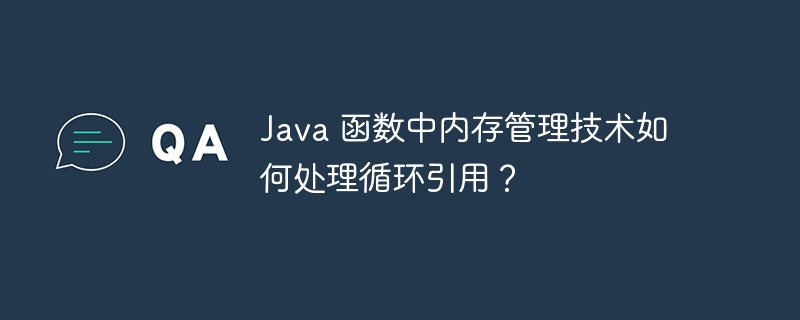Home >Java >javaTutorial >How does memory management technology in Java functions deal with circular references?
How does memory management technology in Java functions deal with circular references?
- WBOYWBOYWBOYWBOYWBOYWBOYWBOYWBOYWBOYWBOYWBOYWBOYWBOriginal
- 2024-05-01 08:36:021015browse
There are the following techniques for handling circular references in Java: Reference counting: Objects track the number of references, but cannot handle circular references. Mark-sweep method: The garbage collector marks reachable objects and clears unmarked objects, including objects with circular references. Weak reference: Does not prevent the garbage collector from collecting the object, even if the reference count is 1. Soft references: Allow the garbage collector to collect objects when memory is low. Virtual reference: only allows the object address to be obtained and does not prevent the garbage collector from collecting the object. WeakHashMap: Use weak references to store key-value pairs and automatically delete keys when they are no longer referenced.

How memory management technology in Java functions handles circular references
Introduction
A circular reference is a memory leak problem that occurs when two or more objects refer to each other. In Java, the garbage collector fails to free objects containing circular references, resulting in memory leaks.
Memory management techniques
Java uses various memory management techniques to handle circular references, including:
- Reference counting: Each object keeps track of the number of references to it. When the reference count drops to 0, the object is garbage collected. However, a circular reference will not bring the reference count down to 0, causing a memory leak.
- Mark-sweep method: The garbage collector traverses the object graph and marks all reachable objects (that is, objects accessible from the root object). After marking, the collector clears all unmarked objects, including objects with circular references.
Practical case
Consider the following class:
class A {
B b;
}
class B {
A a;
}A a = new A(); B b = new B(); a.b = b; b.a = a;
Solution
can be used The following techniques are used to handle circular references:
-
Weak references: Weak references do not prevent the garbage collector from collecting the object, even if the reference count is 1. In the above example,
b.acan be declared as a weak reference. -
Soft references: Soft references allow the garbage collector to collect objects, but only do so when memory is low. In the above example,
a.bcan be declared as a soft reference. - Dummy reference: A virtual reference only allows the address of an object to be obtained without preventing the garbage collector from collecting the object. It is not recommended to use phantom references in practice.
Using WeakHashMap
Java provides the WeakHashMap class, which uses weak references to store key-value pairs. WeakHashMap automatically removes a key when it is no longer referenced by any other object, thus avoiding circular references.
WeakHashMap<A, B> map = new WeakHashMap<>();
Conclusion
It is very important to understand circular references in Java and how to deal with them. By using appropriate memory management techniques, you can prevent memory leaks and improve application performance.
The above is the detailed content of How does memory management technology in Java functions deal with circular references?. For more information, please follow other related articles on the PHP Chinese website!

